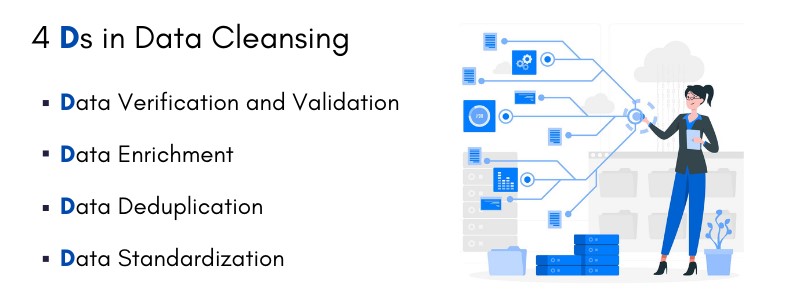Errors may occur when collecting, entering, transforming, extracting, analyzing or transferring data. Incorrect or missing data can result in wrong decision making. Clean data can improve work flow efficiency and productivity. Data cleaning is the first step after data collection. Data cleansing refers to the process of removing wrong or worthless records from the database. As handling complex and large data is not easy and is time-consuming, businesses can consider data cleansing outsourcing. Reliable BPO companies will have experienced data entry staff, who can get the job done right. To streamline the workflow, it is important that the data scientists are capable of detecting and removing major errors and inconsistencies in data. They must also identify the sources of foul data in the database.
Data cleaning techniques may be performed either using advanced data cleansing tools or as batch processing through scripting. Data cleansing and data transformation go hand-in-hand for effective data entry, storage, and management. With well-maintained data, you can save time spent on fixing errors and focus more on your core tasks.
| WHAT IS DATA HYGIENE? BEST PRACTICES TO CONSIDER |
Cleaning your data is important to provide your business with actionable data. Validating and verifying data removes any inaccuracies.
What Are the Benefits of Data Cleaning?
- Increased data efficiency
- Improved customer satisfaction
- Improved decision making
- Easy-to-use data
- No extra spaces or errors
- Missing values are managed
- Unnecessary data is removed
- Unwanted outliers are filtered
- Reduced compliance risks
Data Cleansing Techniques
One among the reliable business process outsourcing companies in USA, we implement some effective data cleansing techniques to provide our clients with accurate and up-to-date data.
Remove Irrelevant and Duplicate Data
The first step is to remove unnecessary and duplicate observations. Duplicate data is common during data collection or data transfer from any other sources. Duplicate content will not only increase the actual amount of data in your database, it can also waste a lot of time. Irrelevant information refers to details that are not at all related to your project. Replace those incomplete or inaccurate data with correct information so that the data set will be uniform compared to other data sets present. Duplicate records can be identified easily through data merging, matching, and comparison. De-duplication can make data analysis more efficient and minimize any distractions.
Data Standardization
Standardizing data involves ensuring the same format exists across datasets. Data collected from different formats can be stored in a common database to make it structured and consistent. Check for capital or lowercase characters and make them all uniform, format dates and use the right measurement units. Storing data in a standard format helps with easy tracking and collaborative research. Take support from data cleansing experts to deal with this time-consuming process and get well-formatted data that is easy to operate.
Identify Missing Values
Never ignore missing values, as it can contaminate the entire data collected. To deal with missing data, consider –
- dropping observations or ignoring the entire column that have missing values
- updating missing values based on other observations (use linear regression or median)
- copying the data from a similar dataset (Hot-deck imputation)
- highlighting and informing that the particular value is missing (using 0 for numeric values)
Remove Typos
Manual data entry may cause some typing mistakes and spelling errors. Such errors can be fixed using multiple algorithms and techniques. Not only the correct spelling, the data format also matters in improving data accuracy. For instance, “Mary” written as “mary” is not the same. In the same way “Dice” written as “Dise” is wrong too. Also, take effort to keep your data uniform. Consider removing unnecessary spaces to keep the data consistent. We run spell and grammar checks to remove grammar and spelling errors.
Data Cleaning – Best Practices
- Save a backup copy of the original data
- Format the database for easy navigation and readability
- Develop a thorough data management plan
- Validate data accuracy
- Correct data at the point of entry
Different data types require diverse types of cleaning methods. Any mistake in the spelling, arrangement, format, or construction can make the data dirty. Professional business process outsourcing companies use different techniques to clean data, which will further improve communication among teams and end-users. Data cleaning also prevents any further IT issues along the line.
| Related Blogs: |





